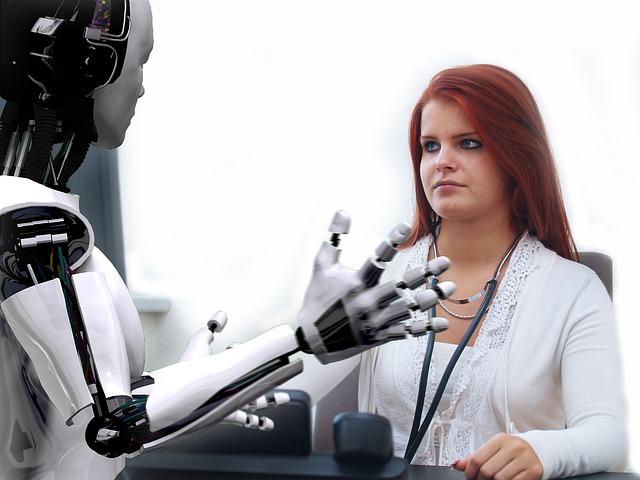In today’s rapidly advancing technological landscape, artificial intelligence (AI) and robotics have emerged as transformative forces, reshaping industries, economies, and societies. This post explores the intricate relationship between humans and machines, delving into the evolution, current state, and future prospects of AI and robotics.
The Evolution of AI and Robotics
The journey of AI and robotics traces back to ancient times, with early civilizations crafting automated mechanisms for various tasks. However, the modern era of AI began in the 1950s, marked by the groundbreaking work of Alan Turing and others. Since then, AI and robotics have evolved through multiple generations, fueled by exponential growth in computing power, data availability, and algorithmic advancements.
The Birth of AI: From Turing Test to Neural Networks
The concept of AI gained prominence with the Turing Test, which proposed evaluating a machine’s intelligence based on its ability to exhibit human-like behavior in conversation. Over time, AI researchers developed various approaches, including symbolic AI and neural networks, leading to significant breakthroughs in natural language processing, computer vision, and machine learning.
The Rise of Robotics: From Industrial Automation to Humanoid Robots
Parallelly, robotics evolved from its roots in industrial automation to encompass a wide spectrum of applications. Early robotic systems focused on repetitive tasks in controlled environments, but advancements in sensors, actuators, and AI algorithms have enabled the development of sophisticated robots capable of interacting with humans and navigating complex environments.
Applications of AI and Robotics
AI and robotics have permeated virtually every sector, revolutionizing processes, enhancing efficiency, and unlocking new possibilities. From healthcare to manufacturing, transportation to entertainment, the impact of AI and robotics is profound and multifaceted.
Healthcare: Precision Medicine and Robotic Surgery
In healthcare, AI aids in diagnosis, personalized treatment planning, and drug discovery, leveraging vast datasets to identify patterns and insights beyond human capacity. Robotics play a crucial role in surgical procedures, enabling greater precision, minimally invasive techniques, and remote surgery, thus improving patient outcomes and recovery times.
Manufacturing: Smart Factories and Collaborative Robots
In manufacturing, AI-powered automation streamlines production processes, optimizes supply chains, and enhances quality control. Collaborative robots, or cobots, work alongside human workers, increasing productivity and flexibility while ensuring safety and ergonomic standards.
Transportation: Autonomous Vehicles and Traffic Management
The transportation sector is undergoing a paradigm shift with the advent of autonomous vehicles and AI-driven traffic management systems. Self-driving cars promise to revolutionize mobility, reduce accidents, and alleviate traffic congestion, while AI algorithms optimize routes, schedules, and logistics across various modes of transport.
Ethical and Societal Implications
Despite their transformative potential, AI and robotics raise significant ethical, societal, and philosophical concerns. As machines become increasingly autonomous and intelligent, questions of accountability, bias, privacy, and job displacement come to the forefront.
Ethical Dilemmas: Bias and Fairness in AI
AI systems are susceptible to biases inherent in their training data, raising concerns about fairness, discrimination, and societal impact. Addressing these biases requires careful algorithmic design, transparent decision-making processes, and diverse representation in AI development teams.
Societal Impact: Employment and Workforce Displacement
The widespread adoption of AI and robotics has sparked fears of job displacement and economic disruption. While automation may eliminate certain roles, it also creates new opportunities for skill development, entrepreneurship, and innovation. Policies focusing on retraining, lifelong learning, and social safety nets are essential to mitigate the adverse effects of technological change.
The Future of Human-Machine Interaction
Looking ahead, the future of AI and robotics holds promise for even closer collaboration and integration between humans and machines. As technologies mature and societal norms evolve, human-machine interaction will become more seamless, intuitive, and symbiotic.
Augmented Intelligence: Enhancing Human Capabilities
Augmented intelligence, which combines human expertise with AI-driven insights, will empower individuals across domains such as education, healthcare, and creative endeavors. By leveraging AI as a tool for amplifying human potential, we can tackle complex challenges and unlock new frontiers of knowledge and innovation.
Robotics in Everyday Life: Personal Assistants and Companion Robots
In the domestic sphere, robotics will play an increasingly integral role, serving as personal assistants, caregivers, and companions. From household chores to emotional support, robots will augment human capabilities, enhance quality of life, and foster social connections in an aging population.
Conclusion
AI and robotics represent a convergence of human ingenuity and technological innovation, reshaping the way we live, work, and interact. By embracing the opportunities and addressing the challenges posed by these transformative technologies, we can forge a future where humans and machines collaborate synergistically, advancing progress and prosperity for all.






